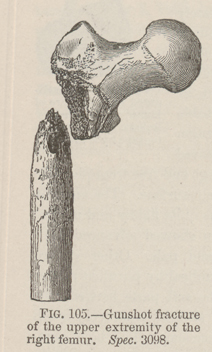Title: O'Neil, Michael
Source text: The Medical and Surgical History of the War of the Rebellion. (1861-65.), Part 3, Volume 2 (Washington, DC: Government Printing Office, 1883), 150-151.
Civil War Washington ID: med.d2e6835
TEI/XML: med.d2e6835.xml
CASE 327.—Private Michael O'Neil,² Co. E, 58th Massachusetts, aged 19 years, was wounded at the battle of Cold Harbor, June 3, 1864, by a conoidal musket ball, which entered the upper anterior part of the right thigh, and passed backward and slightly upward through the limb, comminuting the upper extremity of the femur. The fissures extended about three inches down the shaft, and through the trochanters halfway up the neck. The wounded man was sent in an ambulance to the White House, on the York River, and thence by a hospital steamer to Alexandria, where he was received at the Third Division Hospital on June 7th. On admission his limb was much swollen, yet there was but little pain, and this was not increased by moving the limb. His general condition was satisfactory, though he reported that he was subject to attacks of intermittent fever. His limb was arranged in a straight position, supported by cushions and pillows; evaporating lotions were applied to the wound, and a nutritious diet was ordered. On June 10th, several fragments of bone were extracted. On June 12th the patient had a chill, and was ordered to take four grains of sulphate of quinia every four hours. The injured limb was now suspended by means of Smith's anterior splint. On June 24th there was another chill. The wound was now suppurating freely, and the limb was very sensitive when handled. On June 31st there was a slight chill. From this date to August 1st there was little change in the symptoms. It was now decided that there was little hope of consolidation of the fracture. The suppuration was profuse, and it was believed that the patient would inevitably succumb ultimately to the constitutional irritation and the drain upon the system. It was determined, therefore, that amputation should be performed, and the character of the fracture admitted only of amputation at the hip joint. On August 10th, the patient was anæsthetised by sulphuric ether, and amputation at the hip joint was performed by the lateral flap method by Surgeon Edwin Bentley, U. S. V. There was but little hæmorrhage, and the operation was borne well. The patient had an anodyne, and was freely stimulated. For forty-eight hours after the operation there was some febrile excitement, with complete anorexia. The fever then subsided and the appetite returned. The wound looked well, and the amount of suppuration was trifling. The case progressed very favorably until August 20th, when secondary hæmorrhage supervened from ulceration of the femoral near the ligature. About six ounces of blood were lost. A ligature was promptly placed upon the external iliac just above Poupart's ligament. After the operation the patient was very weak and faint, and stimulants were freely administered. On August 22d there was an excess of febrile excitement, but this abated on the following day and the appetite again became moderately good. On August 28th there was nausea and vomiting, which persisted for forty-eight hours. The wound at this time had assumed a very unhealthy appearance, and the patient had become much emaciated. On the night of September 1st there was delirium. The case terminated fatally on the morning of September 3d, twenty-three days after the operation. At the autopsy the viscera was found to be healthy, except that there was an old cicatrix with cretaceous deposit at the apex of the left lung. The lips of the wound were united in nearly their entire extent. There was a large accumulation of pus within the flap, bathing the acetabulum and the gaping mouth of the femoral artery. The wound left by the incision above Poupart's ligament, through which the external iliac was tied, communicated with an abscess between the iliacus externus muscle and the iliac fascia, filled with pus. The ligature on the external iliac was found to be placed about half an inch below the origin of the epigastric; the circumflex iliac was given off a little below the epigastric. There was a firm conical plug in the external iliac, ending at the origin of the epigastric. Through this plug ran a canal communicating with the mouth of the circumflexa ilii; this canal was closed by a clot colored by included red corpuscles and of more recent formation than the plugging clot. Ulceration of the external iliac just above the ligature had commenced. The femoral vein was collapsed and contracted; the external iliac vein was distended by a dirty fluid, which, when placed under the microscope, was found to abound in pus globules. Higher up, the contents of the vein consisted of a granular detritus. The branches of the external iliac vein was blocked up by dense coagula. The deep-seated abdominal lymphatic glands were enlarged and deeply injected. An examination of the fractured femur showed that it was shattered, with much loss of substance, just below the trochanters. The fissures ran up with the capsule, and the fractured extremities of the bone were carious and had lost tissue by absorption.
² The abstract of this case was compiled from a report by the operator, Surgeon E. BENTLEY, U. S. V. See Circular No. 7, S. G. O., 1867, p. 39.
